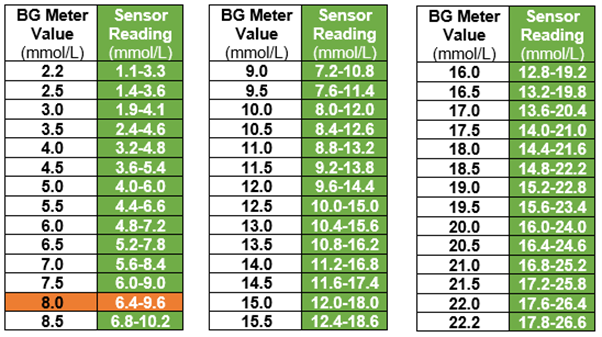Is my Dexcom sensor accurate?
DEXCOM ONE CONTINUOUS GLUCOSE MONITORING SYSTEM READING AND METER VALUE
Whether you’re new to Dexcom or experienced, review product instructions before using the Dexcom ONE. Keep using your BG meter to make treatment decisions until you know how Dexcom works for you. Your meter gives you one number, if you test twice (using the same or a different meter) it gives you another number, and your Dexcom ONE gives you a third. What do you do with all those numbers?

The test
The blood glucose test your doctor does is considered a more accurate glucose number than any products you use at home. Both meters and Dexcom ONE are compared to that doctor’s test to measure accuracy in clinical studies. They are not compared to each other. Additionally, keep in mind that CGM systems measure the interstitial glucose that deviates slightly from the current blood glucose due to physiological reasons. Because of this, the Dexcom ONE reading and meter value are unlikely to be exactly the same number, but they should be close. A difference between blood glucose readings and Dexcom CGM readings of up 1.1 mmol/L for readings lower than 3.9 mmol/L and up to 20% for readings higher than 3.9 mmol/l is within the medically acceptable range that is the industry standard.
The rule
To use the 20/20% rule follow these steps using the table below:
- In the first column, find the BG meter value closest to yours.
- In that row, check whether your sensor reading fits into the range in the second column.
- If it fits, treat using the number that best fits your symptoms, whether it’s from your Dexcom ONE or your BG meter.
- If it doesn’t fit, don’t treat with your Dexcom ONE. Use your BG meter value instead.
For example, if your BG meter value is 8.0 mmol/L (shown in orange in the following table) and your sensor reading is:
- 7.0 mmol/L, treat using either your Dexcom ONE or your BG meter
- 6.0 mmol/L, treat using your BG meter and submit a Product Support Request to report the issue to Dexcom.

This table provides sensor readings that are within ± 20% of the BG meter value for BG meter values ≥3.9 mmol/L and within ± 1.1 mmol/L of the BG meter value for BG meter values <3.9 mmol/L.
Good fingerstick practices
When using your meter, make sure:
- Your test strips are stored as directed and not expired.
- Your hands are clean for the fingerstick. Wash your hands thoroughly with soap and water (not hand gel) and dry them. Then test.
There are times when the numbers temporarily don’t match but are likely to become closer over time. For example:
- Sensor’s first day. With newly inserted sensors, the differences between your meter value and the Dexcom ONE reading may be greater. Generally, the match gets closer over the first 24 hours.
- Glucose changing quickly. When your glucose is changing quickly, it’s more difficult to compare numbers. The meter and Dexcom ONE measure glucose from different sources (blood and interstitial fluid), and blood glucose changes a little before interstitial fluid glucose. The match gets closer and easier to compare when your glucose stabilizes.
- Pressure on sensor. When something is pressing on your sensor it can affect your Dexcom ONE readings. The match should get closer after the pressure is relieved.
To determine what to do, watch your Dexcom ONE readings over several hours. If the readings are always higher (or always lower) than your meter values and always more than 20% difference, please submit a Product Support Request or reach out to your HCP for further assistance.
It is important to trust your own body and your symptoms. If the way you feel does not match your CGM readings, or if you have any doubts, always take a blood glucose reading for comparison.
LBL1003381 Rev001
